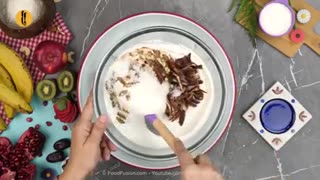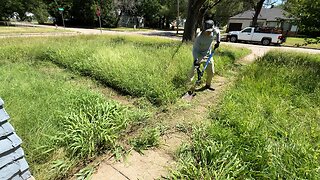Premium Only Content

Safety in the Kitchen_ Chopping Boards _ understanding Dirty Cloths
### **Safety in the Kitchen: Chopping Boards and Dirty Cloths**
Maintaining a safe kitchen environment is critical to prevent cross-contamination and ensure food safety. Two major culprits for spreading harmful bacteria are **chopping boards** and **dirty cleaning cloths**. Here’s how to manage these effectively:
---
### **Chopping Boards: Key Risks and Safety Practices**
#### **Why Chopping Boards are a Risk**
- **Cross-Contamination**: Raw food residue, like juices from raw meat or fish, can transfer bacteria (e.g., Salmonella, Campylobacter) to ready-to-eat foods.
- **Hidden Bacteria**: Deep scratches, grooves, and cracks in chopping boards can harbor bacteria, making cleaning ineffective.
- **Allergens**: Trace allergens left on boards can be dangerous for customers with food allergies.
#### **Best Practices for Chopping Boards**
1. **Use Colour-Coded Boards**:
Assign specific colours for different food types:
- **Red**: Raw meat
- **Blue**: Raw fish
- **Yellow**: Cooked food
- **Green**: Vegetables and salads
- **White**: Dairy and bakery items
This prevents accidental cross-use between food types.
2. **Clean After Each Use**:
- Scrub boards thoroughly with hot, soapy water immediately after use.
- Sanitize with a food-safe disinfectant to kill bacteria.
3. **Check for Damage**:
- Inspect boards regularly for cracks, grooves, or excessive wear.
- Replace boards showing signs of damage, as these areas can trap bacteria.
4. **Separate Boards for Allergens**:
- Use separate, clearly marked boards for foods containing allergens like nuts or gluten to avoid cross-contact.
5. **Storage**:
- Store boards vertically to ensure they dry thoroughly, preventing moisture build-up, which encourages bacterial growth.
---
### **Dirty Cloths: Key Risks and Safety Practices**
#### **Why Dirty Cloths are a Risk**
- **Spread of Bacteria**: Cleaning cloths used repeatedly without washing can transfer bacteria from one surface to another.
- **Moisture**: Damp cloths are a breeding ground for bacteria.
- **Cross-Contamination**: Using the same cloth for multiple tasks (e.g., wiping a raw meat surface and a prep area) spreads contaminants.
#### **Best Practices for Cleaning Cloths**
1. **Use Disposable Cloths**:
- Single-use, disposable cloths are the safest option to prevent bacterial spread.
2. **Wash Reusable Cloths Properly**:
- Launder cloths at high temperatures (at least 60°C) after every use.
- Avoid reusing cloths without washing them first.
3. **Keep Tasks Separate**:
- Assign specific cloths for different tasks, such as:
- One for cleaning raw meat surfaces.
- Another for wiping ready-to-eat prep areas.
- Colour-code cloths (e.g., red for raw meat areas, blue for general surfaces) to minimize mistakes.
4. **Sanitize Cloths During Use**:
- Soak cloths in a food-safe sanitizer between uses to reduce bacterial build-up.
5. **Dry Cloths Thoroughly**:
- Allow cloths to dry completely before reuse to discourage bacterial growth.
---
### **Practical Tips for Kitchen Safety**
#### **Chopping Boards and Cloth Management Together**
- **Cleaning Schedule**: Implement a cleaning schedule that includes chopping boards and cloths. Use checklists to track cleaning frequency and ensure compliance.
- **Training**: Train staff to understand the risks and follow best practices, such as:
- Switching cloths and boards during tasks.
- Cleaning and sanitizing equipment immediately after use.
- **Regular Inspections**: Supervisors should regularly inspect chopping boards and cleaning materials for wear, cleanliness, and proper use.
#### **The Role of SFBB in Kitchen Safety**
- Use the **Safer Food Better Business (SFBB)** pack to establish documented procedures for managing equipment hygiene.
- Record cleaning tasks, training, and monitoring to demonstrate compliance during inspections.
---
### **What to Avoid**
1. **Mixing Raw and Ready-to-Eat Prep Areas**: Always keep separate equipment and cloths for these zones.
2. **Using Worn Equipment**: Replace boards and cloths as soon as they show signs of wear.
3. **Skipping Cleaning Steps**: Rinse, clean, sanitize, and dry—don’t skip any steps.
---
By managing chopping boards and cleaning cloths effectively, you can greatly reduce the risk of cross-contamination and ensure a safer kitchen environment.
Would you like a **custom cleaning checklist** for your kitchen or further advice on training your staff?
-
 2:26
2:26
HSESafetyInformation
22 hours agoCreamy Fruit Chaat Recipe By Food Fusion (Ramazan Special Recipe)
311 -
 36:01
36:01
TimcastIRL
18 hours agoThe Green Room #82 - Timcast Discord & Building Culture in the Digital Space with Roma Nation
84.8K13 -
 1:00:59
1:00:59
IsaacButterfield
20 hours ago $2.14 earnedSHOCKING Nurses Rant About Killing Israelis | Kanye Bombshell | USAID Spending
28.8K23 -
 11:38
11:38
MrBigKid
1 day ago $0.95 earnedSIG 556 Classic SWAT: The Swiss-Inspired Rifle for 'Merica
20.5K2 -
 1:13:32
1:13:32
Tommy's Podcast
2 months agoMedia Decentralization | Sam Anthony (TPC #1,640)
16.2K1 -
 1:01:05
1:01:05
Trumpet Daily
1 day ago $5.24 earnedMEGA Will Backfire on MAGA - Trumpet Daily | Feb. 14, 2025
15.2K20 -
 1:42:23
1:42:23
Game On!
17 hours ago $4.63 earnedEagles Super Bowl Parade EPIC Fail!
36K9 -
 3:29:22
3:29:22
FreshandFit
17 hours agoFresh&Fit After Hours Valentine's Day Edition
192K159 -
 35:31
35:31
SB Mowing
1 day agoThis FORGOTTEN property needed a MIRACLE after nearly a DECADE of ruin
195K53 -
 3:03:44
3:03:44
The Why Files
4 days agoCOMPILATION: Pyramids, Mounds and Mountains
182K90